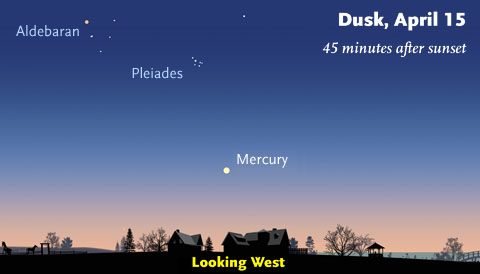
How to Spot Mercury in the Evening Sky
If you've never seen this fleet-footed planet, now is a great time to look for it in the evening sky after sunset.
Right now Jupiter reigns supreme in the evening sky after sunset. But it's not the only bright planet in view. For the next week you can spot Mercury low in the west about 45 minutes after sunset. If you're never seen the innermost planet before, this is a good month to look for it.
Because it's the innermost planet, Mercury is never far from the Sun in the sky. This proximity makes it tricky to spot — when Mercury is above the horizon, the Sun usually is too; when the Sun has dropped from sight enough for the sky to be dark, it's usually dragged the planet along as well. Even in the very best of geometric circumstances, Mercury and the Sun can never appear more than 28° apart in the sky.

If your sky is clear after sunset, Mercury is easy to spot low in the west during mid-April.
Sky & Telescope diagram
Sky & Telescope diagram
Moreover, this fast-moving planet orbits the Sun so quickly, once every 88 days, that it can't stay put for very long. Instead, it jumps between the morning and evening sky multiple times each year.
But some times are better than others for trying to glimpse this celestial speedster — and this is one of those times. Mercury is in the midst of its best evening-sky appearance of the year. And its angular separation from the Sun will reach 20°, what astronomers call greatest elongation, on April 18th.
So if you've got an unobstructed view toward west and it's clear at sunset, step outside for a few minutes to track down this elusive planet. Bring along binoculars if you have them, so you can take in one last view of the Pleiades, somewhat higher up in the western sky, before they sink out of view in the coming weeks.
But don't wait too long! Mercury is getting a little dimmer with each passing day, and by early May it will be too low and faint to spot.

No comments:
Post a Comment